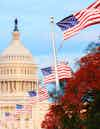Introduction
This paper describes the process that governs whether or not employees have union representation. In the United States, the National Labor Relations Act (“NLRA” or “Act”) governs how most employees can exercise the right to have union representation if they choose. The NLRA—originally enacted in 1935, with important amendments in 1947 and 1959—protects the right “to form, join, or assist” a union, and it also protects “the right to refrain from any or all of such activities...”
The NLRB is the agency responsible for enforcing the NLRA, which gives the NLRB two main responsibilities. First, after a union representation petition is filed, the NLRB is required to investigate the petition and conduct a secret-ballot election to determine whether a majority of employees supports or opposes union representation. Second, if a charge is filed alleging that an employer or union has violated the Act, the NLRB decides whether the employer or union engaged in unlawful conduct, which is called an unfair labor practice. In unfair labor practice cases, the Board’s General Counsel functions as the agency’s prosecuting attorney. However, the Board decides whether any alleged violations have merit, and the Board’s decisions can be appealed to the federal courts of appeals, and possibly, the U.S. Supreme Court.
An NLRB case called Joy Silk Mills, Inc., decided in 1949, indicated that employers could lawfully refuse to grant union recognition, even if a union produced authorization cards signed by a majority of employees, where the employer had a “bona fide doubt as to the union’s majority.” However, the Board held it was unlawful for an employer to refuse to bargain based on “a rejection of the collective bargaining principle” or “a desire to gain time within which to undermine the union,” which the Board evaluated by examining “unlawful conduct of the employer, the sequence of events, and the time lapse between the refusal and the unlawful conduct.”
As explained in this report, the Joy Silk approach—which focused on an employer’s “good or bad faith” in refusing to bargain with a union that has never prevailed in the NLRB election—was subsequently abandoned by the Board. And two more recent Supreme Court cases—Gissel (decided in 1969) and Linden Lumber (decided in 1974)—reaffirmed that NLRB-conducted secret ballot elections are the “preferred” and “favored” method of determining employee sentiments about unions. In these cases, the Court described signed union authorization cards as being “admittedly inferior,” and upheld NLRB bargaining orders in the absence of an election only when “outrageous,” “pervasive” or other unlawful conduct seriously impedes the possibility of having a fair NLRB-conducted election.
In the past eight decades, Congress, the Supreme Court, other courts, and the NLRB have given substantial attention to the rights of employees, employers, and unions. Likewise, the NLRA and relevant cases clearly establish whether and when an employer is required to extend recognition to a union as the exclusive representative of employees. As discussed more fully in this paper, the consistent answer has been uniform: a union is entitled to recognition as the “exclusive” representative of employees only when it prevails in an NLRB-conducted secret ballot election, unless an employer voluntarily decides to extend recognition (based on a showing of majority support). The only exception recognized by the Supreme Court in Gissel (and by the Board decision in Joy Silk) are situations where unfair labor practices are pervasive or extensive to a degree that warrants a finding that a fair election cannot be conducted.





